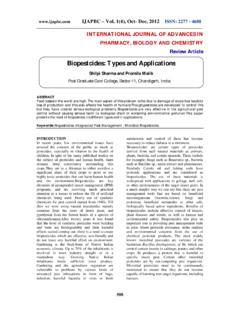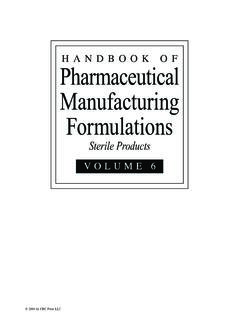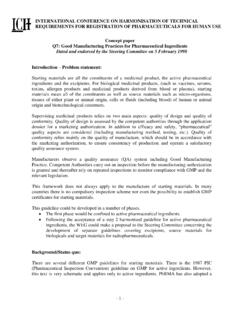Transcription of Pharmaceutical Excipients: A review
1 IJAPBC Vol. 1(1), Jan- Mar, 2012 _____ 21 INTERNATIONAL JOURNAL OF ADVANCES IN PHARMACY, BIOLOGY AND CHEMISTRY review Article ABSTRACT excipients play an important role in formulating a dosage form. These are the ingredients which along with Active Pharmaceutical ingredients make up the dosage forms. excipients act as protective agents, bulking agents and can also be used to improve bioavailability of drugs in some instances, the following review discusses the various types and sources of excipients along with their uses, and these can be used for different activities. Specific excipients are best suited for a particular dosage form; the selection criterion for excipients and various interactions that an excipient can undergo during its course of stay in formulation has been discussed in this review .
2 Some excipient interactions can be detrimental and need to be avoided. This has been detailed out in the interaction section. excipients as like other active Pharmaceutical ingredients need to be stabilized and standardized; the following review gives brief information about standardization and stabilization process alongwith the safety evaluation parameters of the excipients . Keywords: excipient, Interactions, co-processed excipients , Standardization. INTRODUCTION1-5 Many dosage forms formulated today are complex system containing many other components along with the active Pharmaceutical ingredient (API); these compounds are generally added along with the active Pharmaceutical ingredients in order to Protect, support or enhance stability of the formulation:- Most of the times it is observed that the active Pharmaceutical ingredient in its pure form does not retain its stability for long which results in its denaturation, or sticking to the container wall thus rendering it unfit, hence in order to stabilize the API excipients are added which aid in maintaining the stability of the product and ensures that API retains its stability for a considerable period of time thus improving the shelf life of dosage formulation.
3 Bulk up the formulation in case of potent drug for assisting in formulation of an accurate dosage form. Improve patient acceptance. Help improve bioavailability of active drug: - excipients usually help in improving the bioavailability of the active Pharmaceutical ingredient for In many cases an active substance (such as aspirin) is not absorbed easily by human body in such cases the active ingredient is dissolved in or mixed with an excipient which may either act as solvent or assist in absorption of the drug in human body. Enhance overall safety and effectiveness of the formulation during its storage and use. These components are generally termed as excipients and according to the international Pharmaceutical excipient council, Excipient is defined as Any substance other than active drug or pro-drug that is included in the manufacturing process or is contained in finished Pharmaceutical dosage forms.
4 The US pharmacopoeia-National formulary (USP-NF) categorizes excipients according to the functions they perform in the formulations Binders, disintegrants etc. excipients can be classified on the basis of their origin, use in dosage form, and functions they perform as follows 1. Excipient based on their origin5 Animal source: - Lactose, Gelatin, Stearic acid, Bees wax, Honey, Musk, Lanolin etc. Pharmaceutical excipients : A review Shilpa P Chaudhari* and Pradeep S Patil Marathwada Mitra Mandal s College of Pharmacy, Thergaon, Pune, Maharashtra, India. IJAPBC Vol. 1(1), Jan- Mar, 2012 _____ 22 Vegetable source: - Starch, Peppermint, Turmeric, Guar gum, Arginates, Acacia etc. Mineral source: - Calcium phosphate, Silica, Talc, Calamine, Asbestos, Kaolin, Paraffin, etc.
5 Synthetic: - Boric acid, Saccharin, Lactic acid, Polyethylene glycols, Polysorbates, Povidone etc. 2. The following tables gives a classification of various excipients used in Pharmaceutical dosage forms: (table no 1,2,3) 3. Classification of excipients based on their functions 10-13:- excipients are classified on the basis of the functions they perform such as:- Various excipients used in solid dosage forms perform various functions like:- Binders, diluents, lubricants, disintegrating agent s plasticizers etc, : when 5% starch is used in formulation it acts as a binder for tablet formulations where as when it is used in dry form it can perform the function of a disintegrant. excipients that are used in liquid dosage forms are:- Solvents co- solvents, buffers anti-microbial agents emulsifying agents sweetening agents, flavors, etc Some excipients have therapeutic values which are classified as under:- Anesthetics 10:- chloroform, etc Laxatives: - bentonite, psyllium, xanthan gum11, guar- gum etc.
6 Ph modifiers: - citric acid. Astringent: - cinnamon, alum, zinc sulphate. Carminative: - cinnamon13, dill water, anise water. Nutrient sources: - agar12, lactose, etc. Excipient selection 14:- excipients can be considered as indispensible component of medicinal products and in most of the formulations they are present in greater proportion with regards to active Pharmaceutical ingredient, as it forms the bulk of the formulation it is always necessary to select an excipient which satisfies the ideal properties for a particular excipient. Excipient selection generally focuses on the desirable characteristics of excipients such as functionality, material consistency, regulatory acceptance, cost, availability, and sources. Material properties like micromeritics, chemical thermal rheological, mechanical etc also play an important role in development of drug formulation.
7 Formulators must also consider physicochemical properties, stability and compatibility issue, pharmacokinetic attributes, permeation characteristics, segmental absorption behavior, drug delivery platform, intellectual property issues etc while selecting an excipient for formulation development, this may help in determining the absorption challenges and desired delivery platform for active Pharmaceutical ingredients . The concept of quality by design (QbD) helps in understanding excipients normal variability and its potential impact on the processes of formulation development can be achieved. Excipient compatibility tests allows us to determine drug excipient interactions which can be either avoided or can be modified to utilize in an efficient manner which helps in minimizing the risk associated with the excipients .
8 Excipient selection also depends on various routes of administrations. Excipient selection must be done on the basis of characteristics an excipient offers. The ideal characteristics of an excipient are given as under:- An excipient must be:- Chemically stable Non reactive Low equipment and process sensitive Inert to human body Non toxic Acceptable with regards to organoleptic characteristics Economical Having efficiency in regards with the intended use. excipients even though considered inert substance, have the tendency to react with drug components, other excipients , and also the packaging system. excipients may also contain various impurities which may result in decomposition of the active Pharmaceutical ingredients in the formulation thus altering the shelf life of the formulation.
9 The various type of interactions that an excipient can undergo are termed as Drug-Excipient interactions Excipient-Excipient interactions Package-Excipient interactions These interactions are discussed in detail as follows:- Drug Excipient interaction15-19 In Pharmaceutical dosage forms the active Pharmaceutical ingredients are in intimate contact with the excipients which are in greater quantity. excipients and drugs may have certain incompatibilities which lead to drug excipient interaction. IJAPBC Vol. 1(1), Jan- Mar, 2012 _____ 23 excipients affect the physicochemical characters of the active Pharmaceutical ingredient which may lead to formation of molecular complexes, increase in rate of chemical degradation etc.
10 Drug excipient interactions are further classified as Physical interactions Chemical interactions Biopharmaceutical interactions a. Physical interactions: - physical interactions alter the rate of dissolution, dosage uniformity, etc. physical interactions do not involve chemical changes thus permitting the components in the formulation to retain their molecular structure. Physical interactions are difficult to detect. Physical interactions can be either beneficial or detrimental to the product performance which is dependent on its application. Various types of physical interactions are listed as in table no 4. b. Chemical interactions: - active Pharmaceutical ingredients and excipients react with each other to form unstable compounds. Several chemical drugs excipient interactions have been reported in literature.













